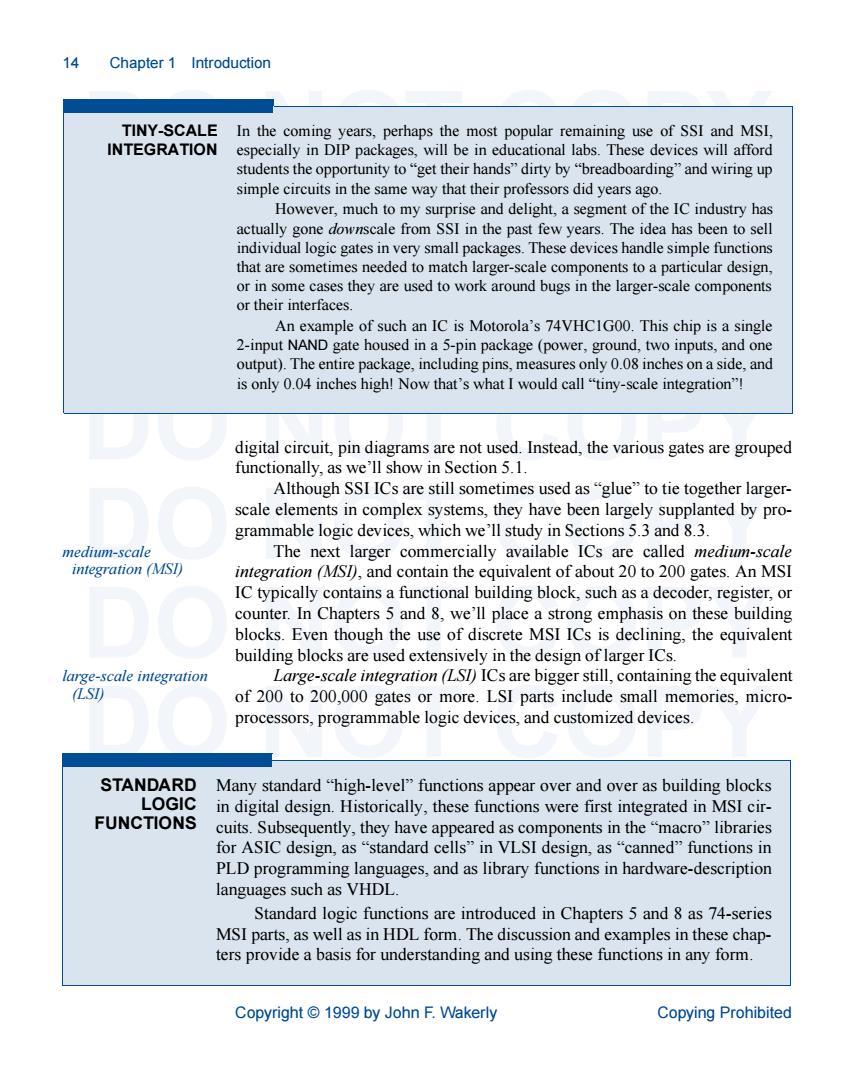正在加载图片...

14 Chapter 1 Introduction TINY-SCALE In the coming years,perhaps the most popular remaining use of SSI and MSI, INTEGRATION in DIP p es.will be ined simple circuits in the same way that their professors did years ago. However,much to my surprise and delight,a segment of the IC industry has actually gone downscale from SSI in the past few years.The idea has been to sell individual logic gates in very small packages These devices handle simple functions that are sometimes needed to match larger-scale components to a particular desigr 0 some ases they are used to work around bugs in the larger-scale components or their interface An example of such an IC is Motorola's 74VHCIG00.This chip is a single 2-input NAND gate housed in a 5-pin package (power,ground,two inputs,and one output).The entire package,including pins,measures only 0.08 inches on a side,and is only 0.04 inches high!Now that's what I would call"tiny-scale integration"! digital circuit,pin diagrams are not used.Instead,the various gates are grouped functionally e'll show in Section 5.1. Although SSI ICs are still sometimes used as"glue"to tie together larger- scale elements in complex systems,they have been largely supplanted by pro- grammable logic devices,which we'll study in Sections 5.3 and 8.3. medium-scale The next larger commercially available ICs are called medium-scale integration (MSI integration (MS),and contain the equivalent of about 20 to 200 gates.An MSI IC typically contains a functional building block.such as a decoder,register.or counter.In Chapters 5 and 8,we'll place a strong emphasis on these building blocks.Even though the use of discrete MSI ICs is declining,the equivalent building blocks are used extensively in the design of larger ICs. arge scale integration(LSI)ICs are bigger still,containing the equivalent of 200 to 200,000 gates or more.LSI parts include small memories,micro- processors,programmable logic devices,and customized devices. STANDARD Many standard"high-level"functions appear over and over as building blocks in digital design.Historically,these functions were first integrated in MSI cir- FUNCTIONS cuits.Subsequently,they have appeared as components in the"macro"libraries for ASIC design,as“standard cells'”in VLSI design,as“canned”functions in PLD programming languages,and as library functions in hardware-description anguages such as vHDL Standard logic functions are introduced in Chapters 5 and 8 as 74-series MSI parts,as well as in HDL form.The discussion and examples in these chap- ters provide a basis for understanding and using these functions in any form. Copyright 1999 by John F.Wakerly Copying Prohibited 14 Chapter 1 Introduction DO NOT COPY DO NOT COPY DO NOT COPY DO NOT COPY DO NOT COPY DO NOT COPY DO NOT COPY DO NOT COPY DO NOT COPY Copyright © 1999 by John F. Wakerly Copying Prohibited digital circuit, pin diagrams are not used. Instead, the various gates are grouped functionally, as we’ll show in Section 5.1. Although SSI ICs are still sometimes used as “glue” to tie together largerscale elements in complex systems, they have been largely supplanted by programmable logic devices, which we’ll study in Sections 5.3 and 8.3. The next larger commercially available ICs are called medium-scale integration (MSI), and contain the equivalent of about 20 to 200 gates. An MSI IC typically contains a functional building block, such as a decoder, register, or counter. In Chapters 5 and 8, we’ll place a strong emphasis on these building blocks. Even though the use of discrete MSI ICs is declining, the equivalent building blocks are used extensively in the design of larger ICs. Large-scale integration (LSI) ICs are bigger still, containing the equivalent of 200 to 200,000 gates or more. LSI parts include small memories, microprocessors, programmable logic devices, and customized devices. TINY-SCALE INTEGRATION In the coming years, perhaps the most popular remaining use of SSI and MSI, especially in DIP packages, will be in educational labs. These devices will afford students the opportunity to “get their hands” dirty by “breadboarding” and wiring up simple circuits in the same way that their professors did years ago. However, much to my surprise and delight, a segment of the IC industry has actually gone downscale from SSI in the past few years. The idea has been to sell individual logic gates in very small packages. These devices handle simple functions that are sometimes needed to match larger-scale components to a particular design, or in some cases they are used to work around bugs in the larger-scale components or their interfaces. An example of such an IC is Motorola’s 74VHC1G00. This chip is a single 2-input NAND gate housed in a 5-pin package (power, ground, two inputs, and one output). The entire package, including pins, measures only 0.08 inches on a side, and is only 0.04 inches high! Now that’s what I would call “tiny-scale integration”! STANDARD LOGIC FUNCTIONS Many standard “high-level” functions appear over and over as building blocks in digital design. Historically, these functions were first integrated in MSI circuits. Subsequently, they have appeared as components in the “macro” libraries for ASIC design, as “standard cells” in VLSI design, as “canned” functions in PLD programming languages, and as library functions in hardware-description languages such as VHDL. Standard logic functions are introduced in Chapters 5 and 8 as 74-series MSI parts, as well as in HDL form. The discussion and examples in these chapters provide a basis for understanding and using these functions in any form. medium-scale integration (MSI) large-scale integration (LSI)